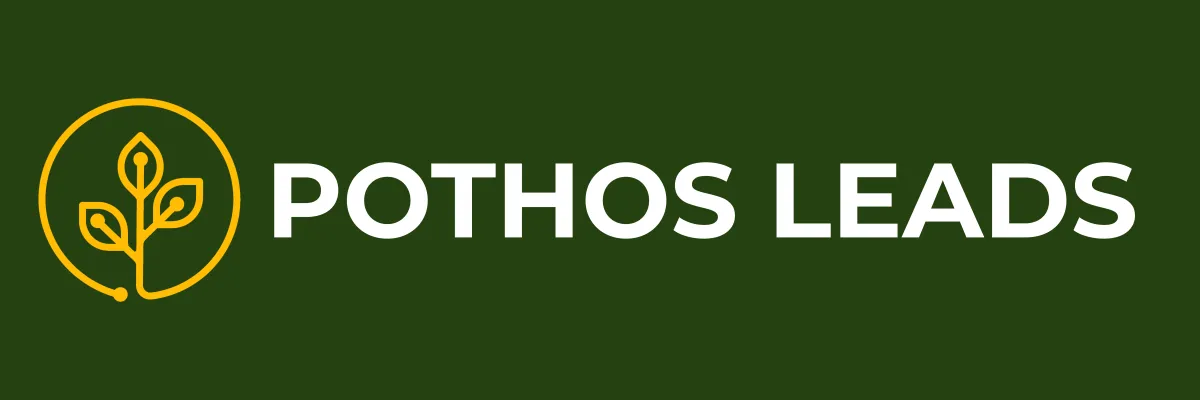
The Pothos Leads Post | July 1
What Makes a Lead ‘Qualified’? A Breakdown for Smarter Outreach
Clear lead criteria drive higher conversions, faster pipelines, and stronger ROI. Here’s how to refine yours.
Most businesses aren’t struggling with a lack of leads—they’re struggling with too many of the wrong ones.
In fact, 67% of lost sales are the direct result of poor lead qualification. -MarketingSherpa
And only 25% of leads that sales teams engage with are typically legitimate. -Gleanster Research

The solution isn’t more outreach. It’s better filtering.
That begins with clearly defining what a qualified lead looks like—not in theory, but in the specific, measurable context of your business model, capacity, and goals.
Here’s how to sharpen that definition, why it matters, and how it transforms your lead generation strategy.
Why Lead Qualification Drives Performance
Even with a solid Ideal Client Profile, too many businesses rely on surface-level qualification: contact info, industry, job title.
But effective qualification considers timing, buying intent, budget range, and role in the decision-making process. Without these, your sales team wastes time pursuing leads who won’t—or can’t—convert.
💡 Companies that excel at lead qualification generate 50% more sales-ready leads at 33% lower cost.
Rethinking “Qualified”: A Business-Centric Lens
If you're outsourcing lead generation—or running it in-house—your team (or agency) needs a clear framework that distinguishes interest from intent.
Here’s what to define beyond demographics:
1. Urgency + Timing
Is the lead actively seeking a solution now, or gathering info for a future decision?
Are they in a buying window aligned with your sales cycle?
2. Budget Alignment
Can they realistically afford your product/service tier?
Do they understand the investment level involved?
🔍 According to HubSpot, price mismatch is one of the top three reasons deals fall through late in the pipeline.
3. Decision-Making Role
Are you speaking to the person who can say yes—or someone who has to get permission?
If multiple stakeholders are involved, how long is their internal process?
4. Strategic Fit
Does their business model align with your offer?
Will they be a profitable, sustainable client—or just a short-term win?
These aren’t philosophical questions. They’re filters that save time, protect your margins, and strengthen your client roster.
Lead Qualification in Practice
If you’re using a CRM or working with an agency, you need a repeatable framework to assess and categorize lead quality—ideally before a call is even booked.
Many teams use a system like BANT (Budget, Authority, Need, Timing) or CHAMP (Challenges, Authority, Money, Prioritization). The model matters less than consistency.
The goal is to apply qualification early in the funnel, ideally during or before initial outreach—so sales conversations happen only with high-fit prospects.
📊 Teams that implement lead scoring see a 77% increase in lead generation ROI. -MarketingSherpa

What This Means for Your Lead Generation Strategy
If you're getting leads that don't convert, it’s likely a targeting or qualification breakdown.
You might be:
Attracting the wrong tier of prospect
Using messaging that appeals to browsers, not buyers
Missing essential pre-qualification data in your intake process
Prioritizing volume over alignment
Refining your qualified lead definition helps correct all of these.
Better Input = Better Output
Lead generation is not just about finding contacts. It’s about reaching the right people, at the right time, with the right expectations.
That starts with clarity:
What level of awareness and urgency do your ideal leads have?
What are your non-negotiables for budget, industry, or personality fit?
What signals (in behavior, job role, or timing) indicate strong intent?
The more clearly you define this, the more accurately your team—or agency—can target, message, and convert.
A Strategic Lead Engine Starts with Qualification
Defining what makes a lead “qualified” isn’t about limiting your funnel. It’s about protecting your sales time and maximizing ROI.
If you’re already investing in lead generation, this clarity ensures you're not just filling the top of the funnel—but fueling a pipeline that moves.

Ready to Build a Smarter Lead System?
At Pothos Leads, we design outreach strategies around your qualification criteria—so your calendar fills with conversations that count.
Let’s take the guesswork out of lead generation.
👉 Book a strategy call to explore a lead system built for alignment, not just activity.
Recent Posts

Lead Quantity vs. Quality: Why the Wrong Clients Drain...

How to Create Your Ideal Client Profile to Attract Better Leads

